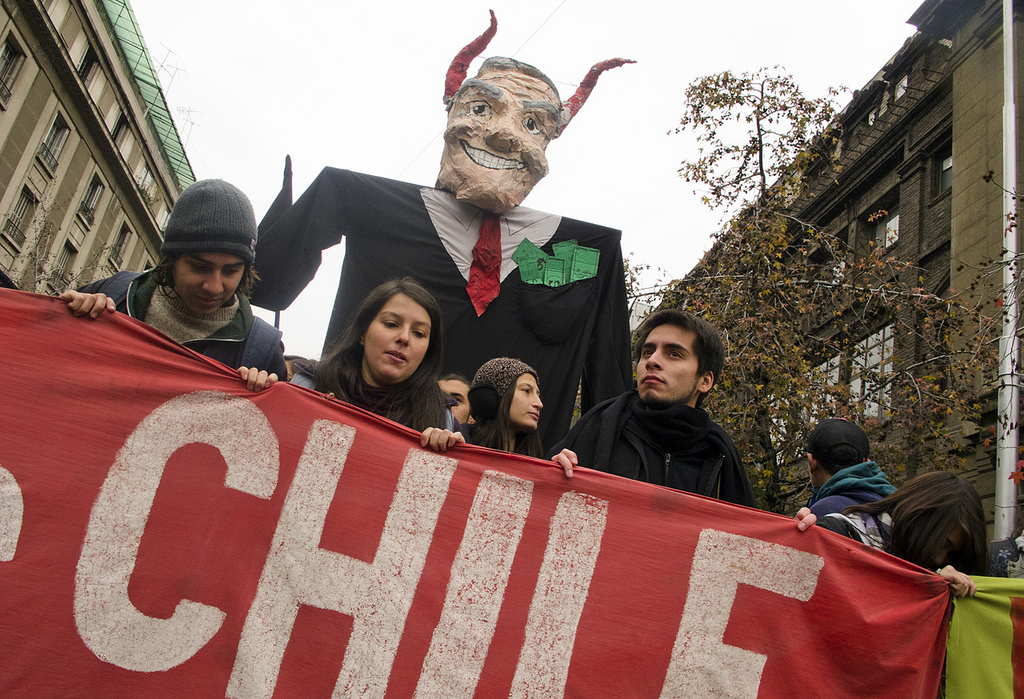This post is part of our special coverage #Occupy Worldwide [1].
Despite 81 million unemployed youth in the world, “Only 4.4 percent of global income is spent on education and a fraction of that on youth unemployment,” Former Prime Minister Gordon Brown writes in an article called, “Give The Kids Jobs! [3]”
This can serve as good a tip-off as any as to why Chile is Chile. It spends 4.4% of its GDP on education, below what the UN suggests for developed countries (7%), and why – as the President of the American Federation of Teachers pointed out in a previous interview with the writer – Chile’s results “have not been impressive — at least as measured by PISA [4],” a form of international testing that puts them second from the bottom of 56 countries, cushioned only by Peru.
For the past five months, Chilean students have been actively responding to this, which Global Voices has documented (see: October 12th [5], August 10th [6], and more [7].) As American media outlets begin to come to terms with Occupy Wall Street (who are barrelling forward at a rapid clip), they can look at the texture of what’s happening in a country where — unlike Egypt and Tunisia — there is neither a Dictator nor an infrastructure gap, but inequality, inequality, inequality.
In a blog post for the Harvard Business Review published during the first week of Occupy Wall Street, James Allworth postulated that the real choice at hand was a choice between capitalism and democracy [8] and how the friction between the two would be resolved.
That friction — and that issue (Chile’s wealth distribution ranks among the world’s worst [9]) — is manifesting itself within the call for free education. As of 2009, only 27% of Chilean students who could be enrolled in educational institutions were enrolled. No new public universities have been built since Pinochet. Schools are funded locally, which means the quality of the school depends on the monetary quality of the area. More Chileans are going to Argentina for school because it’s cheaper.
The end game for the middle class can either follow one of two routes: stay healthy and fine and avoid the idea of an end game altogether, or follow what Elizabeth Warren has been tracking, most notably in The Two-Income Trap [11].
Though income-wages have been stagnant for the past forty years in the United States, income volatility has occurred with a ninety percent frequency for a family with two children between 1970 and 2003.
A few things constitute income volatility — and it can be found across borders.
In Chile, blogger Ricardo Acuña writes [12] that one can pay for their groceries on their credit card in installments. In 2009, the median income was listed at 735,503 pesos [13]/1,570 dollars per month.
La Polar — the fourth largest retail company in Chile — had unilaterally renegotiated credit card arrangements with 418,000 Chileans for six years. The New York Times reports [14] that “annual interest charges can top 220 percent and consumers cannot seek bankruptcy protection.”
The Times continues:
… consumer debt rose by 254 percent, to roughly $34 million, between 2001 and 2008, the debt-to-income level topped 70 percent at the end of 2010, according to the Central Bank.
And since there is no bankruptcy protection, Chileans have to worry about falling on the Dicom, something which is — essentially — a credit agency for people: if you have bad credit, you’ll be blacklisted from a job and find it harder to get a loan.
The economic health of a middle class family matters. Eliminate economic malfeasance and it is safer for the family and safer for the country in which they reside. As Paul Krugman has noted, anything that inflates income inequality — meaning: anything that shrinks the middle class by widening the gap between the rich and the poor — could seriously provoke — and be an indicator of – a financial crisis [15]. Attack inequality and you attack risk.
Anyone familiar with the #OWS [16] #needsoftheoccupiers [17] hashtags will see an instant rapport when Shalini Adnani walked to the University of Chile [18]:
A sign at the entrance urged for help: “We Need (education): Sheets, toilet paper, liquid soap, soap dish soap, brooms, paper towels, deodorant, cardboard, any games, and love.”
Adnani continues:
But as I walked inside students welcomed me with the creativity that defined the student movement. A man dressed as Captain Jack Sparrow with a Jolly Roger flag hanging from his belt holds my chin with the tip of his cutlass humorously asking for identification.
…
Students continue to educate classmates and other Chileans asking trivia questions about Chilean history on a microphone … Enthusiastic schoolgirls sat in a circle in a ‘literature of the dictatorship’ workshop where students partaking in strikes and occupation of schools continued to learn and explore their interests despite the suspension of classes … The zeal students shared for knowledge was ever-present. Flyers for different kinds of workshops — film, environmental policy, theater, and education itself — were topics students themselves studied and taught each other.
In the “Acuerdo Social por la Educación Chilena [19],” a “Social Agreement for Chilean Education,” which was written by the students, one paragraph reads:
Esto implica entender la educación como una inversión social y no meramente individual, necesaria para la batalla contra la desigualdad y el alcance de la libertad y la justicia social.
This past Sunday, October 8, The New York Times wrote [20]:
At this point, protest is the message: income inequality is grinding down that middle class, increasing the ranks of the poor, and threatening to create a permanent underclass of able, willing but jobless people. On one level, the protesters, most of them young, are giving voice to a generation of lost opportunity.
In an interview with Harald Beyer [21], leader of the student movement Camila Vallejo — explaining why the students were protesting — said, simply,
“La democracia no se ejerce necesariamente una vez cada cuatro años en una urna.”
This post is part of our special coverage #Occupy Worldwide [1].


